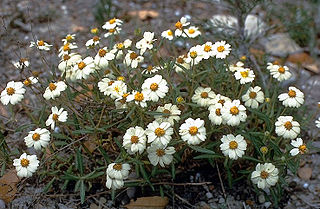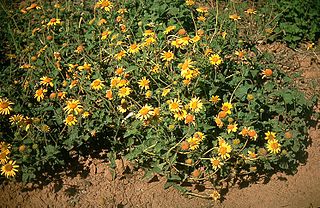Related Research Articles
Harold Ernest Robinson was an American botanist and an entomologist.

Melampodium is a genus of flowering plants in the sunflower family.

Spilanthes is a genus of African and South American plants in the sunflower tribe within the daisy family.

The Heliantheae are the third-largest tribe in the sunflower family (Asteraceae). With some 190 genera and nearly 2500 recognized species, only the tribes Senecioneae and Astereae are larger. The name is derived from the genus Helianthus, which is Greek for sun flower. Most genera and species are found in North America and South America, particularly in Mexico. A few genera are pantropical.
Synantherology is a branch of botany that deals with the study of the plant family Asteraceae. The name of the field refers to the fused anthers possessed by members of the family, and recalls an old French name, synantherées, for the family.
Erato is a genus of flowering plants belonging to tribe Liabeae of the sunflower family. It is found from Costa Rica to Bolivia, with its main centre of diversity in Ecuador.
Asanthus is a small genus of flowering plants in the daisy family, found only in northern Mexico and the southwestern United States.
Critoniella is a genus of South American flowering plants in the sunflower family.
Dyscritogyne is a genus of Mexican flowering plants in the daisy family, Asteraceae.
Oxylobus is a genus of Mesoamerican flowering plants in the boneset tribe within the sunflower family.
Steviopsis is a genus of Mexican plants in the boneset tribe within the sunflower family.

Simsia is a genus of flowering plants in the sunflower tribe within the daisy family. It includes annuals, herbaceous perennials, and shrubs. They range from the western United States south through Central and South America to Argentina, with the center of diversity occurring in Mexico. The genus is named for British physician and botanist John Sims (1749–1831). Although some species are relatively rare, others have become common weeds that line the roadsides and fields of Mexico, often forming dense stands mixed with Tithonia and other Asteraceae. Some species are known by the common name bushsunflower.
Otopappus is a genus of flowering plants in the sunflower tribe within the daisy family, primarily Mesoamerican but with one species from Jamaica.
Chrysactinium is a genus of South American flowering plants in the daisy family.
Brickellia diffusa is a Latin American species of flowering plants in the daisy family. It is widespread across much of South America, Central America, Mexico, Galápagos, and the West Indies. Its distribution stretches from Sonora and Tamaulipas in northern Mexico to Jujuy in northern Argentina.
Isocarpha oppositifolia, the Rio Grande pearlhead, is a New World species of plants in the sunflower family. It is widely distributed in eastern and southern Mexico, Central America, the West Indies, and northern South America. The range extends northward, just barely crossing to the north side of the Río Grande in the two southernmost counties in Texas.
Isocarpha atriplicifolia is a New World species of plants in the sunflower family. It is widely distributed in southern Mexico, Central America, the West Indies, and northern South America.
Isocarpha megacephala is a New World species of plants in the sunflower family. It has been found only in northeastern Brazil.
Isocarpha microcephala is a New World species of plants in the sunflower family. It has been found only in Perú and Ecuador.
Isocarpha fistulosa is a New World species of plants in the sunflower family. It has been found only in Perú and Ecuador.
References
- 1 2 3 Flann, C (ed) 2009+ Global Compositae Checklist
- ↑ Tropicos, Isocarpha R. Br.
- ↑ "Isocarpha". Natural Resources Conservation Service PLANTS Database. USDA . Retrieved 25 May 2015.
- ↑ Brown, Robert. 1817. Observations on the Natural Family of Plants called Compositae 110
- ↑ Tropicos, Isocarpha R. Br.
- ↑ "Isocarpha R. Brown". Flora of North America .
- 1 2 Keil, David J.; Stuessy, Tod F (1981). "Systematics of Isocarpha (Compositae: Eupatorieae)". Systematic Botany. American Society of Plant Taxonomists. 6 (3): 258. doi:10.2307/2418285. JSTOR 2418285.
- ↑ Weberling, F. H. E. & J. A. Lagos. 1960. Neue Blütenpflanzen für El Salvador - C.A. (Vorläufige Liste). Beitrage zur Biologie der Pflanzen 35(2): 177–201
- ↑ Turner, B. L. 1997. The Comps of Mexico: A systematic account of the family Asteraceae, vol. 1 – Eupatorieae. Phytologia Memoirs 11: i–iv, 1–272
- ↑ Keil, D. J. and T. F. Stuessy. 1981. Systematics of Isocarpha (Compositae: Eupatorieae). Systematic Botany 6: 258–287.
- ↑ Biota of North America Program 2013 county range map